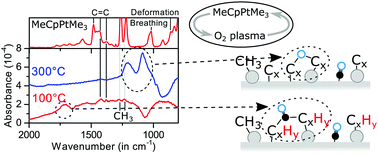Surface species during ALD of platinum observed with in situ reflection IR spectroscopy†
Abstract
Thermal atomic layer deposition (ALD) and plasma-enhanced ALD (PE-ALD) of Pt, using MeCpPtMe3 as the precursor and O2 gas or O2 plasma as the reactant, are studied with in situ reflection Fourier transform infrared spectroscopy (FTIR) at different substrate temperatures. This is done to identify the functional groups present during Pt ALD and investigate the origin of the temperature dependent growth rate of the thermal process. Evidence is given that CH and C![[double bond, length as m-dash]](https://www.rsc.org/images/entities/char_e001.gif) C containing species are present on the surface after precursor exposure at low substrate temperatures (<150 °C), poisoning the surface during thermal ALD. Both species are removed by O2 plasma enabling PE-ALD below 150 °C through combustion reactions. Above 150 °C, no CH stretching modes were detected and the C
C containing species are present on the surface after precursor exposure at low substrate temperatures (<150 °C), poisoning the surface during thermal ALD. Both species are removed by O2 plasma enabling PE-ALD below 150 °C through combustion reactions. Above 150 °C, no CH stretching modes were detected and the C![[double bond, length as m-dash]](https://www.rsc.org/images/entities/char_e001.gif) C vibration diminished, indicating dehydrogenation reactions and ligand restructuring. In addition, the PE-ALD FTIR spectra revealed the presence of combustion reaction products on the surface after precursor exposure. These were removed during the reactant exposure and during this exposure the formation of surface OH groups was found for both high and low substrate temperatures. We conclude that the decrease in the growth rate for the thermal process is caused by the inability of the surface to properly dehydrogenate and restructure the poisoning precursor ligands.
C vibration diminished, indicating dehydrogenation reactions and ligand restructuring. In addition, the PE-ALD FTIR spectra revealed the presence of combustion reaction products on the surface after precursor exposure. These were removed during the reactant exposure and during this exposure the formation of surface OH groups was found for both high and low substrate temperatures. We conclude that the decrease in the growth rate for the thermal process is caused by the inability of the surface to properly dehydrogenate and restructure the poisoning precursor ligands.



 Please wait while we load your content...
Please wait while we load your content...